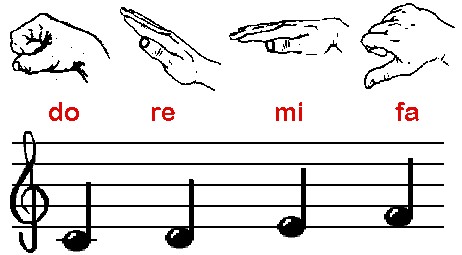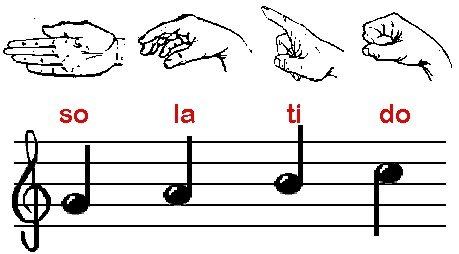Bach-to-Rock Music School
A music teacher's thoughts on learning to play piano and to sing. Topics of interest include: intrinsic motivation, goal setting, practicing, technique, purchasing the proper instrument, performance anxiety, group v. individual instruction, song and piece repertoire, and assessment.
Saturday, July 16, 2011
Thoughts on Memorization
There is a group of piano players on Linkedin that has been discussing memorization. There thoughts are useful and valuable. I hope these ideas are helpful to you as well. See the following link to access: Memorization Tools
Tuesday, July 5, 2011
Solfege Pitches and Curwen Hand Signs
For singers, it is helpful to have a "cheat sheet" as a frame of reference for the Solfege scale. For kinesthetic learners, it is helpful to use the Curwen hand signs when singing solfege. ![]()
In Italy, beginning singers are taught to sing tunes entirely using solfege pitches which is quite remarkable.
When practicing sight-singing, it is helpful to give yourself (your student) a key center (Do) so that he or she can learn to find the other pitches surrounding do. In order to do this, you will need a helpful instrument such as a piano/ keyboard or pitch pipe. Garage Band (both '09 and '11) have virtual midi keyboards for use. Another suggestion is to download an application for your Iphone or Ipod that will give you a starting pitch.
(Ex: Virtuoso Piano free 3) from the Applications Apple Store
Preview of Kodaly websites: The following is an excerpt from the Solfege website (see link below)
Kodaly 101 - Classics for Kids - http://www.classicsforkids.com/teachers/training/Kodaly101.asp
Hand Signals - http://www.classicsforkids.com/teachers/training/handsigns.asp

 "
"
In Italy, beginning singers are taught to sing tunes entirely using solfege pitches which is quite remarkable.
When practicing sight-singing, it is helpful to give yourself (your student) a key center (Do) so that he or she can learn to find the other pitches surrounding do. In order to do this, you will need a helpful instrument such as a piano/ keyboard or pitch pipe. Garage Band (both '09 and '11) have virtual midi keyboards for use. Another suggestion is to download an application for your Iphone or Ipod that will give you a starting pitch.
(Ex: Virtuoso Piano free 3) from the Applications Apple Store
Preview of Kodaly websites: The following is an excerpt from the Solfege website (see link below)
"Singing and Solfege
Your students can learn about melodies and how to read music by using the one instrument we all have free access to - the voice! Kodaly, Mary Helen Richards, Education through Music, and other music methodologies utilize hand signals along with learning to sing and read music. Typically, music in Kodaly starts with the pentatonic (5-note) scale - do, re, mi, sol, la. If you play just the black keys on your piano, you'll hear a pentatonic scale. Below is an example of the hand signals used in a major scale. "Do" is movable meaning that the key or home base of a scale is always do - but do can be any note.
C Scale in Solfege
Tuesday, June 21, 2011
Sight-Reading
Sight-reading is such a valuable skill and in many ways, its an application exercise for music theory knowledge. As always, practice makes perfect, but its important to prepare well. Much preliminary thinking can help you to be a more accurate sight-reader. For example, when I am going to sight-read a piece of music, I determine the key, tonality, and chordal structure throughout the piece. I may even write in the chords (like a lead sheet) and take note of where the cadences occur. It is also important to take into consideration the tempo, time signature, articulation, dynamics, and form of the piece. For students, I recommend writing in the fingering prior to playing as an assist to anchoring hand position throughout the piece. This is a valuable skill for learning music more quickly, and in preparation for Spring Assessments with Certificate of Merit.
Here is an easy and fun piece to sightread this week: "Cool Blues" by X, Richard from www.8notes.comhttp://www.8notes.com/scores/11327.asp
Here is an easy and fun piece to sightread this week: "Cool Blues" by X, Richard from www.8notes.comhttp://www.8notes.com/scores/11327.asp
Monday, June 20, 2011
Composition and Improvisation
There is a wonderful program through MTAC (Music Teachers Association of California) called: Composers Today. Its mission is to provide students with tools to create their own music. These tools include method books to guide composition/ musicianship skills as well as opportunities to perform their original works. Consider enrolling in this option if your son/daughter is inclined towards singer/songwriter capabilities: http://www.mtac.org/programs/ct/index.shtml
Intrinsic Motivation
Welcome! I wanted to create this blog to answer questions I often hear and to get your feedback/ thoughts on so many important topics related to your student's motivation, practicing, goal setting, technique, and other resources to aid in their musical studies.
My Master's research was conducted on the topic of Performance Anxiety and Performance Achievement in high school student singers. (I will discuss some of the hi-lights of this research in this post, and later talk specifically about performance anxiety in singers and how that differs from pianists.)
I found (ranked from the three top highest scoring factors to promote performance achievement and overcome anxiety) that many of these students were able to meet their performance goals when they were given individual attention (one-on-one tutoring), lots of positive feedback, (particularly encouragement) and thirdly when they sung music of their choice. I was surprised to find that such factors as "video feedback" and/or "feedback" didn't score as highly in contributing factors that supported students towards their performance goals. Thus, one-on-one private music instruction is an incredibly valuable investment in the life of your son/daughter. It will help to offer specific positive encouragements to your child as you hear them playing/practicing, such as: "I really liked how you played that section so quietly. It captured the feeling of a lullaby quite nicely."
Individual song choice (though it scored third highest on my Likert Scale) seems to be one of the greatest motivating factors towards practicing for students. It is important for them to be exposed to lots of styles, but they will learn musical concepts from any piece of music, so it is never wrong to allow them to play the music they enjoy.
My Master's research was conducted on the topic of Performance Anxiety and Performance Achievement in high school student singers. (I will discuss some of the hi-lights of this research in this post, and later talk specifically about performance anxiety in singers and how that differs from pianists.)
I found (ranked from the three top highest scoring factors to promote performance achievement and overcome anxiety) that many of these students were able to meet their performance goals when they were given individual attention (one-on-one tutoring), lots of positive feedback, (particularly encouragement) and thirdly when they sung music of their choice. I was surprised to find that such factors as "video feedback" and/or "feedback" didn't score as highly in contributing factors that supported students towards their performance goals. Thus, one-on-one private music instruction is an incredibly valuable investment in the life of your son/daughter. It will help to offer specific positive encouragements to your child as you hear them playing/practicing, such as: "I really liked how you played that section so quietly. It captured the feeling of a lullaby quite nicely."
Individual song choice (though it scored third highest on my Likert Scale) seems to be one of the greatest motivating factors towards practicing for students. It is important for them to be exposed to lots of styles, but they will learn musical concepts from any piece of music, so it is never wrong to allow them to play the music they enjoy.
Subscribe to:
Posts (Atom)